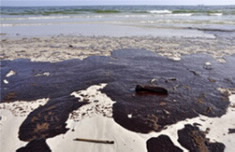FOR IMMEDIATE RELEASE
ACS News Service Weekly PressPac: July 21, 2010
Oil dispersants used in Gulf of Mexico unlikely to be endocrine disrupters and have relatively low toxicity to cells
“Analysis of Eight Oil Spill Dispersants Using Rapid, In Vitro Tests for Endocrine and Other Biological Activity”
Environmental Science & Technology
Government scientists are reporting that eight of the most commonly used oil dispersants used to fight oil spills, such as the massive episode in the Gulf of Mexico, appear unlikely to act as endocrine disrupters — hormone-like substances that can interfere with reproduction, development, and other biological processes. The tested dispersants also had a relatively low potential for cytotoxicity (cell death), with JD-2000 and SAF-RON GOLD showing the least potential. The scientists are with the U. S. Environmental Protection Agency and the National Institutes of Health Chemical Genomics Center. Their findings appear in ACS’ semi-monthly journal Environmental Science & Technology: “Analysis of Eight Oil Spill Dispersants Using Rapid, In Vitro Tests for Endocrine and Other Biological Activity.”
Richard Judson and colleagues note that more than 1.5 million gallons of dispersants have been used so far in the Deepwater Horizon spill. These detergent-like chemicals break up oil slicks into small drops. Scientists are concerned that some dispersants contain ingredients that turn into endocrine disrupters in the environment, and could harm marine mammals, fish, and humans. But only limited toxicity testing data is available on currently-used dispersants, and this is only results from the first round of EPA dispersant testing, they state.
With an urgent need for such information in the Deepwater Horizon spill, the scientists applied a rapid screening method using mammalian cells to determine the eight dispersants’ potential to act as endocrine disrupters and relative toxicity to living cells. The dispersants included a type widely being used to treat the Gulf oil spill. None of the substances showed significant endocrine disruption activity and cytotoxicity was not seen until dispersants were tested at concentrations above 10 parts per million, the scientists said. However, they note that “there are other routes by which chemicals can cause endocrine disruption, as well as other types of toxicity that have not been tested for here.”
![]()
Contact
Science Inquiries: Michael Woods, Editor, 202-872-6293
General Inquiries: Michael Bernstein, 202-872-6042

used to fight oil spills, such as the one shown
here, are unlikely to act as endocrine
disrupters — hormone-like substances that
can harm marine life.
Credit: iStock
(High-resolution version)

